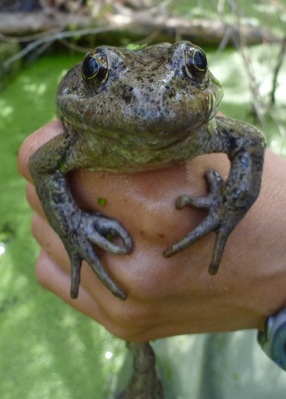|
You are viewing ARCHIVED content published online before January 20, 2025.
Please note that this content is NOT UPDATED, and links may not work. For current information,
visit https://www.nps.gov/aboutus/news/index.htm.

National Park Service
Contact: Kate Kuykendall, 805-370-2343 THOUSAND OAKS, Calif. -- Biologists received some good news this month about plans to re-introduce California red-legged frogs to the Santa Monica Mountains. The isolated population located in the nearby Simi Hills appears to be healthy and reproducing, which is critical to the success of the re-introduction effort planned for next spring. "California red-legged frogs haven't been spotted in the Santa Monica Mountains since the early 1970s," said Katy Delaney, wildlife biologist for Santa Monica Mountains National Recreation Area, a unit of the National Park Service. "Our plan to bring them back here depends on the strength of this relatively tiny and isolated population in the Simi Hills." After conducting night surveys and running the numbers through a population estimate model, researchers with the National Park Service and U.S. Geological Survey calculate there are approximately 100 adult frogs in a small section of Upper Las Virgenes Canyon Open Space Preserve (formerly known as Ahmanson Ranch). The federally listed threatened species has disappeared from 24 of the 46 California counties within its original range. Delaney hopes to transfer eggs from Upper Las Virgenes Canyon to two streams in the Santa Monica Mountains. Although the frogs seem to be thriving, they are limited to only a few hundred yards of stream and could be easily wiped out in a severe drought or other catastrophic event, such as disease. The healthy population of breeding adults, along with the abundance of tadpoles spotted by biologists, bode well for the re-location of the egg masses. California red-legged frogs require deep pools of year-round water, which are not easy to find in the arid climate of the Santa Monica Mountains. Delaney and her team have been surveying area streams to determine where the frogs will have the best chance of survival. Many of the streams in the Santa Monica Mountains are infested with non-native species like crayfish, which can prey on frog eggs and tadpoles. Beginning in the spring of 2014, the project team, which is composed of California State Parks, the Mountains Recreation and Conservation Authority, the National Park Service, Santa Monica Bay Restoration Commission, U.S. Fish and Wildlife Service and USGS Western Ecological Research Center, will begin transferring hundreds of eggs to streams in two undisclosed locations. If the public sees mesh containers suspended above the water, Delaney asks curious visitors to please keep their distance and not disrupt the fragile re-introduction effort. Because frogs have permeable skin that easily absorbs contaminants, they are considered an indicator species that provides important information about habitat health. Nationwide, USGS has documented precipitous declines among amphibians, which some speculate may be linked to habitat loss, invasive species and pollution. Santa Monica Mountains National Recreation Area (SMMNRA) is the largest urban national park in the country, encompassing more than 150,000 acres of mountains and coastline in Ventura and Los Angeles counties. It comprises a seamless network of local, state and federal parks interwoven with private lands and communities. As one of only five Mediterranean ecosystems in the world, SMMNRA preserves the rich biological diversity of more than 450 animal species and 26 distinct plant communities. ### |
Last updated: October 31, 2018
